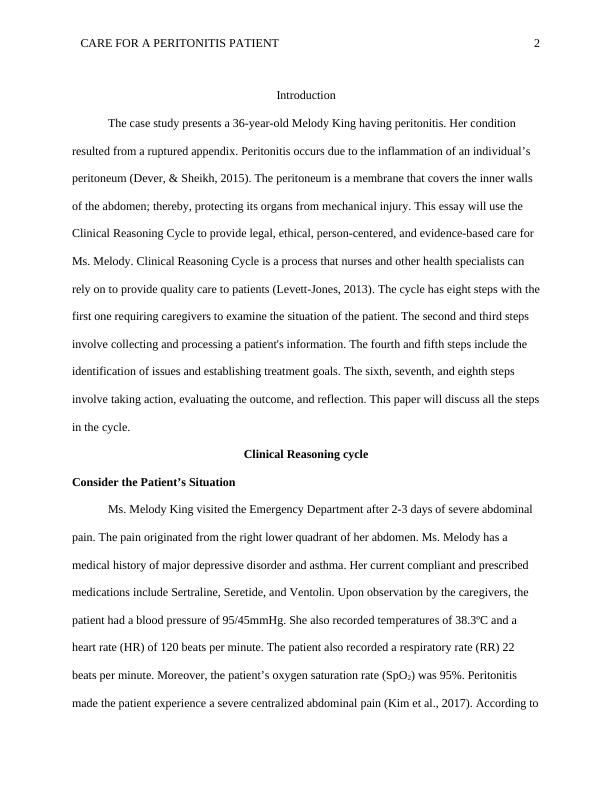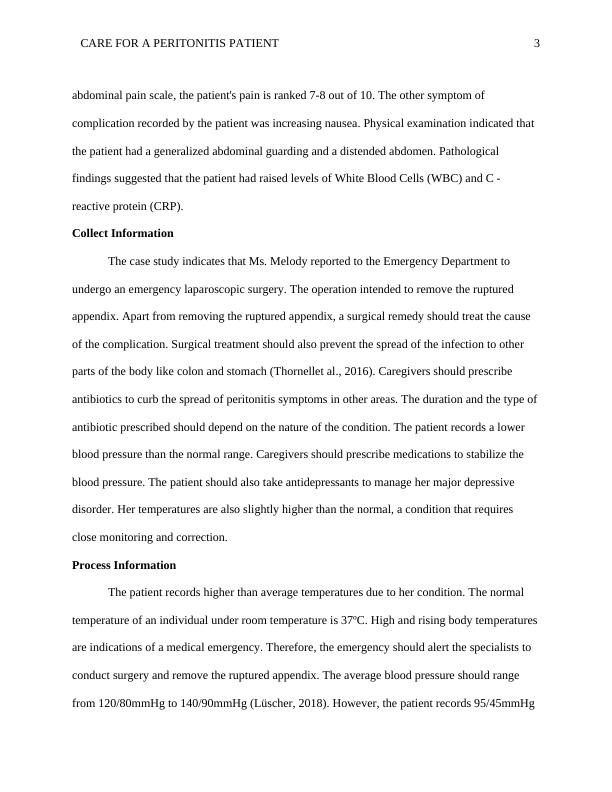Care for a Peritonitis Patient
Added on 2023-04-19
10 Pages2736 Words223 Views
Running head: CARE FOR A PERITONITIS PATIENT 1
Care for a Peritonitis Patient
Student’s Name
Institutional Affiliation
Care for a Peritonitis Patient
Student’s Name
Institutional Affiliation

CARE FOR A PERITONITIS PATIENT 2
Introduction
The case study presents a 36-year-old Melody King having peritonitis. Her condition
resulted from a ruptured appendix. Peritonitis occurs due to the inflammation of an individual’s
peritoneum (Dever, & Sheikh, 2015). The peritoneum is a membrane that covers the inner walls
of the abdomen; thereby, protecting its organs from mechanical injury. This essay will use the
Clinical Reasoning Cycle to provide legal, ethical, person-centered, and evidence-based care for
Ms. Melody. Clinical Reasoning Cycle is a process that nurses and other health specialists can
rely on to provide quality care to patients (Levett-Jones, 2013). The cycle has eight steps with the
first one requiring caregivers to examine the situation of the patient. The second and third steps
involve collecting and processing a patient's information. The fourth and fifth steps include the
identification of issues and establishing treatment goals. The sixth, seventh, and eighth steps
involve taking action, evaluating the outcome, and reflection. This paper will discuss all the steps
in the cycle.
Clinical Reasoning cycle
Consider the Patient’s Situation
Ms. Melody King visited the Emergency Department after 2-3 days of severe abdominal
pain. The pain originated from the right lower quadrant of her abdomen. Ms. Melody has a
medical history of major depressive disorder and asthma. Her current compliant and prescribed
medications include Sertraline, Seretide, and Ventolin. Upon observation by the caregivers, the
patient had a blood pressure of 95/45mmHg. She also recorded temperatures of 38.3ºC and a
heart rate (HR) of 120 beats per minute. The patient also recorded a respiratory rate (RR) 22
beats per minute. Moreover, the patient’s oxygen saturation rate (SpO2) was 95%. Peritonitis
made the patient experience a severe centralized abdominal pain (Kim et al., 2017). According to
Introduction
The case study presents a 36-year-old Melody King having peritonitis. Her condition
resulted from a ruptured appendix. Peritonitis occurs due to the inflammation of an individual’s
peritoneum (Dever, & Sheikh, 2015). The peritoneum is a membrane that covers the inner walls
of the abdomen; thereby, protecting its organs from mechanical injury. This essay will use the
Clinical Reasoning Cycle to provide legal, ethical, person-centered, and evidence-based care for
Ms. Melody. Clinical Reasoning Cycle is a process that nurses and other health specialists can
rely on to provide quality care to patients (Levett-Jones, 2013). The cycle has eight steps with the
first one requiring caregivers to examine the situation of the patient. The second and third steps
involve collecting and processing a patient's information. The fourth and fifth steps include the
identification of issues and establishing treatment goals. The sixth, seventh, and eighth steps
involve taking action, evaluating the outcome, and reflection. This paper will discuss all the steps
in the cycle.
Clinical Reasoning cycle
Consider the Patient’s Situation
Ms. Melody King visited the Emergency Department after 2-3 days of severe abdominal
pain. The pain originated from the right lower quadrant of her abdomen. Ms. Melody has a
medical history of major depressive disorder and asthma. Her current compliant and prescribed
medications include Sertraline, Seretide, and Ventolin. Upon observation by the caregivers, the
patient had a blood pressure of 95/45mmHg. She also recorded temperatures of 38.3ºC and a
heart rate (HR) of 120 beats per minute. The patient also recorded a respiratory rate (RR) 22
beats per minute. Moreover, the patient’s oxygen saturation rate (SpO2) was 95%. Peritonitis
made the patient experience a severe centralized abdominal pain (Kim et al., 2017). According to

CARE FOR A PERITONITIS PATIENT 3
abdominal pain scale, the patient's pain is ranked 7-8 out of 10. The other symptom of
complication recorded by the patient was increasing nausea. Physical examination indicated that
the patient had a generalized abdominal guarding and a distended abdomen. Pathological
findings suggested that the patient had raised levels of White Blood Cells (WBC) and C -
reactive protein (CRP).
Collect Information
The case study indicates that Ms. Melody reported to the Emergency Department to
undergo an emergency laparoscopic surgery. The operation intended to remove the ruptured
appendix. Apart from removing the ruptured appendix, a surgical remedy should treat the cause
of the complication. Surgical treatment should also prevent the spread of the infection to other
parts of the body like colon and stomach (Thornellet al., 2016). Caregivers should prescribe
antibiotics to curb the spread of peritonitis symptoms in other areas. The duration and the type of
antibiotic prescribed should depend on the nature of the condition. The patient records a lower
blood pressure than the normal range. Caregivers should prescribe medications to stabilize the
blood pressure. The patient should also take antidepressants to manage her major depressive
disorder. Her temperatures are also slightly higher than the normal, a condition that requires
close monitoring and correction.
Process Information
The patient records higher than average temperatures due to her condition. The normal
temperature of an individual under room temperature is 37ºC. High and rising body temperatures
are indications of a medical emergency. Therefore, the emergency should alert the specialists to
conduct surgery and remove the ruptured appendix. The average blood pressure should range
from 120/80mmHg to 140/90mmHg (Lüscher, 2018). However, the patient records 95/45mmHg
abdominal pain scale, the patient's pain is ranked 7-8 out of 10. The other symptom of
complication recorded by the patient was increasing nausea. Physical examination indicated that
the patient had a generalized abdominal guarding and a distended abdomen. Pathological
findings suggested that the patient had raised levels of White Blood Cells (WBC) and C -
reactive protein (CRP).
Collect Information
The case study indicates that Ms. Melody reported to the Emergency Department to
undergo an emergency laparoscopic surgery. The operation intended to remove the ruptured
appendix. Apart from removing the ruptured appendix, a surgical remedy should treat the cause
of the complication. Surgical treatment should also prevent the spread of the infection to other
parts of the body like colon and stomach (Thornellet al., 2016). Caregivers should prescribe
antibiotics to curb the spread of peritonitis symptoms in other areas. The duration and the type of
antibiotic prescribed should depend on the nature of the condition. The patient records a lower
blood pressure than the normal range. Caregivers should prescribe medications to stabilize the
blood pressure. The patient should also take antidepressants to manage her major depressive
disorder. Her temperatures are also slightly higher than the normal, a condition that requires
close monitoring and correction.
Process Information
The patient records higher than average temperatures due to her condition. The normal
temperature of an individual under room temperature is 37ºC. High and rising body temperatures
are indications of a medical emergency. Therefore, the emergency should alert the specialists to
conduct surgery and remove the ruptured appendix. The average blood pressure should range
from 120/80mmHg to 140/90mmHg (Lüscher, 2018). However, the patient records 95/45mmHg

End of preview
Want to access all the pages? Upload your documents or become a member.
Related Documents
Clinical Integration Specialty Practice - NRSG370 | Case Studylg...
|11
|2827
|507
Management of Peritonitislg...
|10
|2868
|263
Clinical Integrationlg...
|9
|2518
|306
Nursing Case Study: Levett Jones Clinical Reasoning Cyclelg...
|11
|3191
|121
NRSG370 - Case Study on Clinical Integrationlg...
|12
|2386
|32
Post-Surgical Nursing with Clinical Reasoninglg...
|10
|2447
|360
